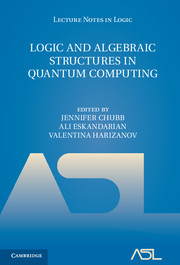Book contents
- Frontmatter
- Contents
- Preface
- Introduction
- 1 A (very) brief tour of quantum mechanics, computation, and category theory
- 2 Could logic be empirical? The Putnam-Kripke debate
- 3 The essence of quantum theory for computers
- 4 Fiber products of measures and quantum foundations
- 5 Operational theories and categorical quantum mechanics
- 6 Relating operator spaces via adjunctions
- 7 Topos-based logic for quantum systems and bi-Heyting algebras
- 8 The logic of quantum mechanics – Take II
- 9 Reasoning about meaning in natural language with compact closed categories and Frobenius algebras
- 10 Knot logic and topological quantum computing with Majorana fermions
- Index
- References
4 - Fiber products of measures and quantum foundations
Published online by Cambridge University Press: 05 June 2016
- Frontmatter
- Contents
- Preface
- Introduction
- 1 A (very) brief tour of quantum mechanics, computation, and category theory
- 2 Could logic be empirical? The Putnam-Kripke debate
- 3 The essence of quantum theory for computers
- 4 Fiber products of measures and quantum foundations
- 5 Operational theories and categorical quantum mechanics
- 6 Relating operator spaces via adjunctions
- 7 Topos-based logic for quantum systems and bi-Heyting algebras
- 8 The logic of quantum mechanics – Take II
- 9 Reasoning about meaning in natural language with compact closed categories and Frobenius algebras
- 10 Knot logic and topological quantum computing with Majorana fermions
- Index
- References
Summary
Abstract. With a view to quantum foundations, we define the concepts of an empirical model (a probabilistic model describing measurements and outcomes), a hidden-variable model (an empirical model augmented by unobserved variables), and various properties of hidden-variable models, for the case of infinite measurement spaces and finite outcome spaces. Thus, our framework is general enough to include, for example, quantum experiments that involve spin measurements at arbitrary relative angles. Within this framework, we use the concept of the fiber product of measures to prove general versions of two determinization results about hidden-variable models. Specifically, we prove that: (i) every empirical model can be realized by a deterministic hidden-variable model; (ii) for every hidden-variable model satisfying locality and λ-independence, there is a realizationequivalent hidden-variable model satisfying determinism and λ-independence.
Introduction. Hidden variables are extra variables added to the model of an experiment to explain correlations in the outcomes. Here is a simple example. Alice's and Bob's computers have been prepared with the same password. We know that the password is either p2s4w6r8 or 1a3s5o7d, but we do not know which it is. If Alice now types in p2s4w6r8 and this unlocks her computer, we immediately know what will happen when Bob types in one or other of the two passwords. The two outcomes—when Alice types a password and Bob types a password—are perfectly correlated. Clearly, it would be wrong to conclude that, when Alice types a password on her machine, this somehow causes Bob's machine to acquire the same password. The correlation is purely informational: It is our state of knowledge that changes, not Bob's computer. Formally, we can consider an r.v. (random variable) X for Alice's password, an r.v. Y for Bob's password, and an extra r.v. Z. The r.v. Z takes the value z1 or z2 according as the two machines were prepared with the first or the second password. Then, even though X and Y will be perfectly correlated, they will also be independent (trivially so), conditional on the value of Z. In this sense, the extra r.v. Z explains the correlation.
- Type
- Chapter
- Information
- Logic and Algebraic Structures in Quantum Computing , pp. 71 - 87Publisher: Cambridge University PressPrint publication year: 2016
References
- 1
- Cited by



